

After we returned to our hotel last evening, the drizzle quickly turned into pouring and continued all night.
Still, we were very optimistic and relaxed because the evening weather forecast expected the rain to calm down by this morning. We soaked in a big hot onsen all to ourselves, enjoyed our dinner, and had a good night’s sleep.
Waking up and opening the window curtains, we found the rain was still going on hard… Well, we still had two hours to start walking, so I was still hopeful that the rain would calm down.

When the hotel car dropped us off at yesterday’s end point by the corner of the Cobalt Line, sadly, it was still raining, but at least not as hard as earlier. It was more like mists and didn’t seem to make our clothes wet immediately without rain jackets.
Mt. Gobansho-yama and the scenic Park

Another two-lane car road with good sidewalks branched away from the Cobalt Line. Following it, the MCT route soon went into a lawn-covered walk path to a big park spreading over the top of the mountain behind Ayukawa. We passed a long slide and zip lines for kids and crossed empty parking lots and a bathroom.



The park’s main area has a couple of view decks and a multi-level observation tower that should give visitors a nearly 360-degree spectacular landscape when it is nice and sunny — it must be great for a weekend picnic.
Even on a foggy day like now, the view of Kinkasan Island from one of the overlook decks was magnificent. The sacred mountain island right before us looked dignified even when a thick white fog hid its head.


The names of the park, Oshika Gobansho Park おしか御番所公園, and the mountain, Gobansho-yama 御番所山, come from the small wooden hut at the peak of the mountain. This hut was called as Karafune Bansho 唐船番所.

Since the mid-17th century, when the lord of the domain for today’s Miyagi Prefecture area set up five of these huts in his territory, they served for 220 years as lookout stations for foreign ships (Karafune) that might have tried to approach Japan under seclusionism.

The MCT route went back to the car road and, again, got into a sideway, a gradually descending forestry path.

We came out in the northernmost corner of the Ayukawa town area and then ended up on the other side of the port, only a few hundred meters away from the visitor center, Whale Town Oshika.
If MCT hikers must hurry up to arrive at the port (in SOBO) or head north (in NOBO), you can easily skip this 8-kilometer tour around Mt. Gobanosyo-yama.

Although another long day of over 30km walking awaited us, I had already gained a lot of confidence from achieving a 35km walk in Ishinomaki City a few days ago. Today’s cooler and misty weather should also help us walk comfortably. So, before the final departure from Ayukawa, we walked back to the visitor center for nice clean bathrooms and hot coffee/tea from vending machines.
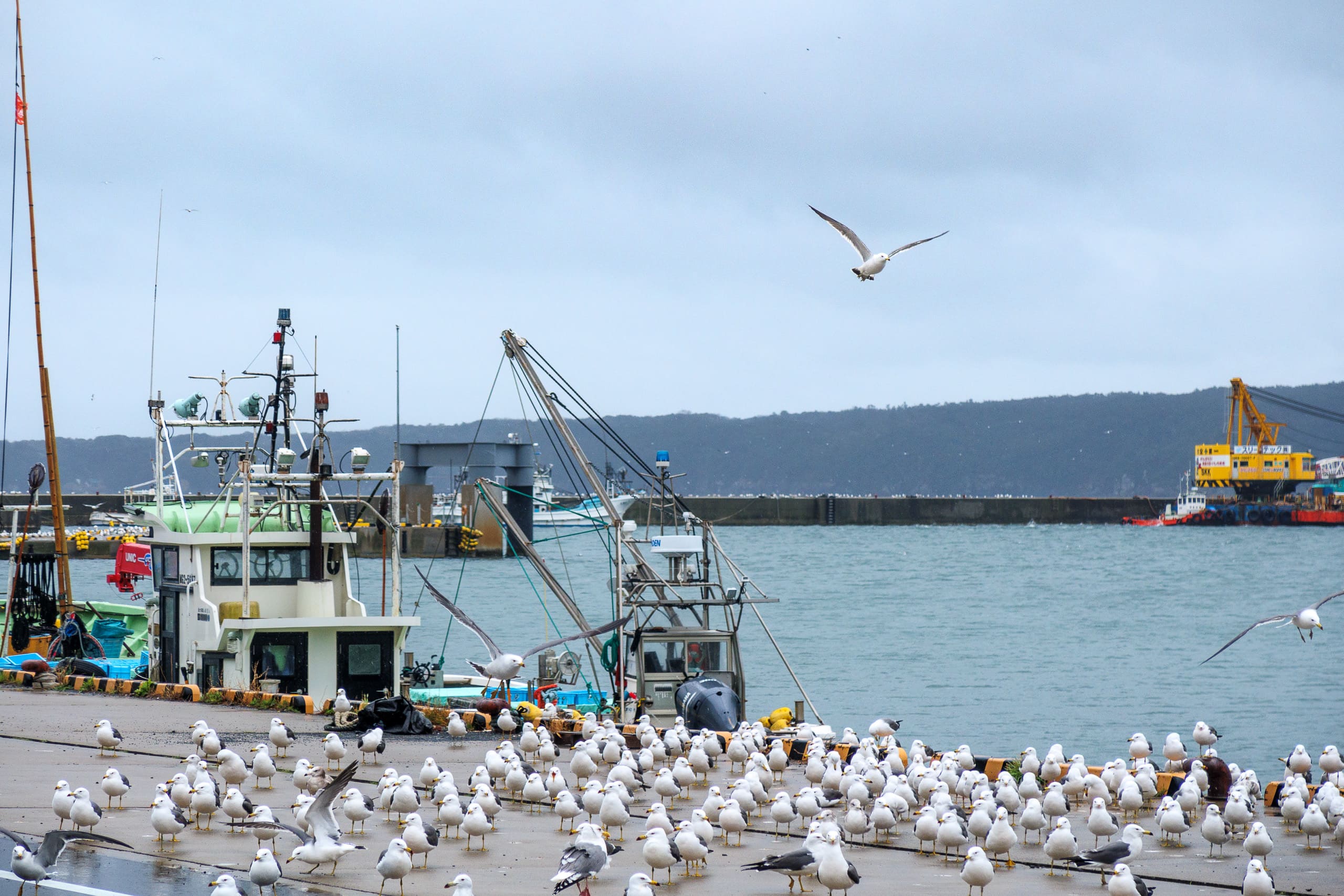


Walking along the Oshika Peninsula west coastline
The misty rain didn’t look like stopping anytime soon. My Arc’teryx Adahy Hoody and Finetrack dry layer warm undershirt were doing a pretty good job of keeping me warm and dry even without a rain jacket.
Today, we were going up north to Momonoura Fishery Port 桃ノ浦漁港. From there, the next town, Onagawa, located at the neck of the Oshika Peninsula, is only a day’s hike away.
The MCT route in this part runs mostly on Prefectural Road 2, which is a long, winding paved car road along the west coastal line of the peninsula and traces the old main travel route from Ishinomaki to visit Kinkasan called Kinkasando 金華山道 back then. While the modern R-2 has two long tunnels to shortcut, the MCT route keeps the traditional way of going up and over the mountain passes. So, we had two more stretch of nature trails.
The west coastline of the Oshika Peninsula looks like a saw, with repeats of bays in between small capes. At every bay, there was a small fishery port and hamlet.



The first bay after Ayukawa was Kugunari-hama 十八成浜.
Half of its coastline was a sandy swimming beach with a big roofed picnic table area and a shower/bathroom building. Thankfully, the bathroom was unlocked, and there was a vending machine, so we enjoyed the clean and modern toilets while taking a short hot drink break at one of the dry picnic tables.


- Daytime use only. No overnight camping is allowed.
- The shower room is NOT available off-season. The beach usually opens from mid-July to the end of August.
- Fire is NOT allowed on the beach, the roofed picnic table area, and the concrete paved space between the bathroom building and the roofed area.
The beach was deserted on an early spring rainy day, but hundreds of seagulls were resting or sun-basing at a corner of the beach.

The next hamlet, Kobuchi 小渕, was by a narrow bay about 5km from Ayukawa. Instead of going straight along R-2, the MCT route detoured to let us walk through the modest fishermen’s neighborhoods.
Thousands of threaded scallop shells piled up higher than me at every corner like fortified walls. We remember the cheerful MCT local supporter, Mr. Suzuki, who helped us cross from the last island of Urado to Miyako on his fishing boat. He showed us oyster farming with threaded scallop shells in the sea.

Erik took a photo of the walls of shells and made a joke post on his Facebook, “We found where all of Camino de Santiago shells are imported from!”
Today’s only and last convenience store was ironically located in the middle of the R-2 part we had skipped to strictly follow the MCT route. But we happily walked back that few hundred meters to the last supply point before two-thirds of today’s walk was still ahead of us.
Sadly, the convenience store didn’t have eat-in tables, and our hope for a dry and comfortable environment to enjoy our lunch was dashed. We kept walking forward and looked for a rest hut or any roofed place, such as a terrace of an old temple or shrine, where we could sit down without bothering locals. Before long, we spotted a roadside concrete shelter with benches inside. A bus stop sign stood in front of it. The bus timetable showed buses didn’t come anytime soon, and no one was around to wait for a bus, so we enjoyed our microwaved hot meals, feeling warm and fulfilled.

The rain remained misty, but my hoody finally started getting a bit wet. Today’s dramatically lower temperature with continuous chilly wind from the sea made me feel a bit cold, especially when we were not moving. Even on the road, passing heavy trucks caused wind blow. So, finally, I pulled my rain jacket out and put it on to keep warm. Better early than sorry.

Not so good things about Walking on R-2 –
As we walked on R-2 between bays, two negative things kept annoying us.
First, road shoulders were super narrow or almost non-existent.
R-2 was an absolute main route to connect downtown Ishinomaki and Ayukawa and quite often, cars and heavy vehicles passed us in both directions. While R-2 through residential areas and ports have sidewalks and a decent width of shoulders, the parts through the capes, which were usually crossing forests, apparently didn’t consider any humans would walk there. Their road shoulders were so limited, often barely 30 centimeters in width, and only a white sideline separated us from the vehicles. The MCT official Mapbook (vol. 8) for these sections also has warnings for that.


As everywhere along the Pacific coastal areas in Tohoku had ongoing big construction projects, building new sea walls and car roads, heavy vehicles frequently passed us walking on where the MCT route follows the car roads. This section was no exception. It didn’t make us feel safe when those massive heavy trucks passed only a few centimeters away from our arms and shoulders all the time.

Second, terrible roadside littering.
A lot of garbage, mostly empty cans and pet bottles of drinks was scattered all over the roadside grass and under trees. It was not in some parts but continued all along the road.
Though most of the cans were coffee or tea, we spotted a shockingly non-negligible number of beer and other alcoholic drinks there, too. Many looked quite new – like they were thrown away just yesterday or this morning. It was pretty depressing when you were hiking and continuously had to walk right next to the sea of littering.

Kozumi-Toge Pass – Kinkasan Island Pilgrimage Route
The first mountain crossing, today’s second natural trail, started from Koamikura port 小網倉漁港. Following the MCT sticker and blue-green tape, we turned to a narrow side road under paving construction. The construction workers there didn’t stop us from entering the road, so we softly greeted them and continued.




The trailhead of the mountain path was behind a graveyard. A signpost with short historical information about the path said this trail was the only local road until R-2 was built in the late 20’s.

The three-kilometer stretch of natural-surfaced trail was wide and gradual enough for carriages, horses and cows. Most parts kept untouched from their original conditions and well-maintained except for occasional fallen trees. The thick fallen leaves covered all the way, so red and orange in wet condition. They gave our feet a nice bouncy cushion the entire time.

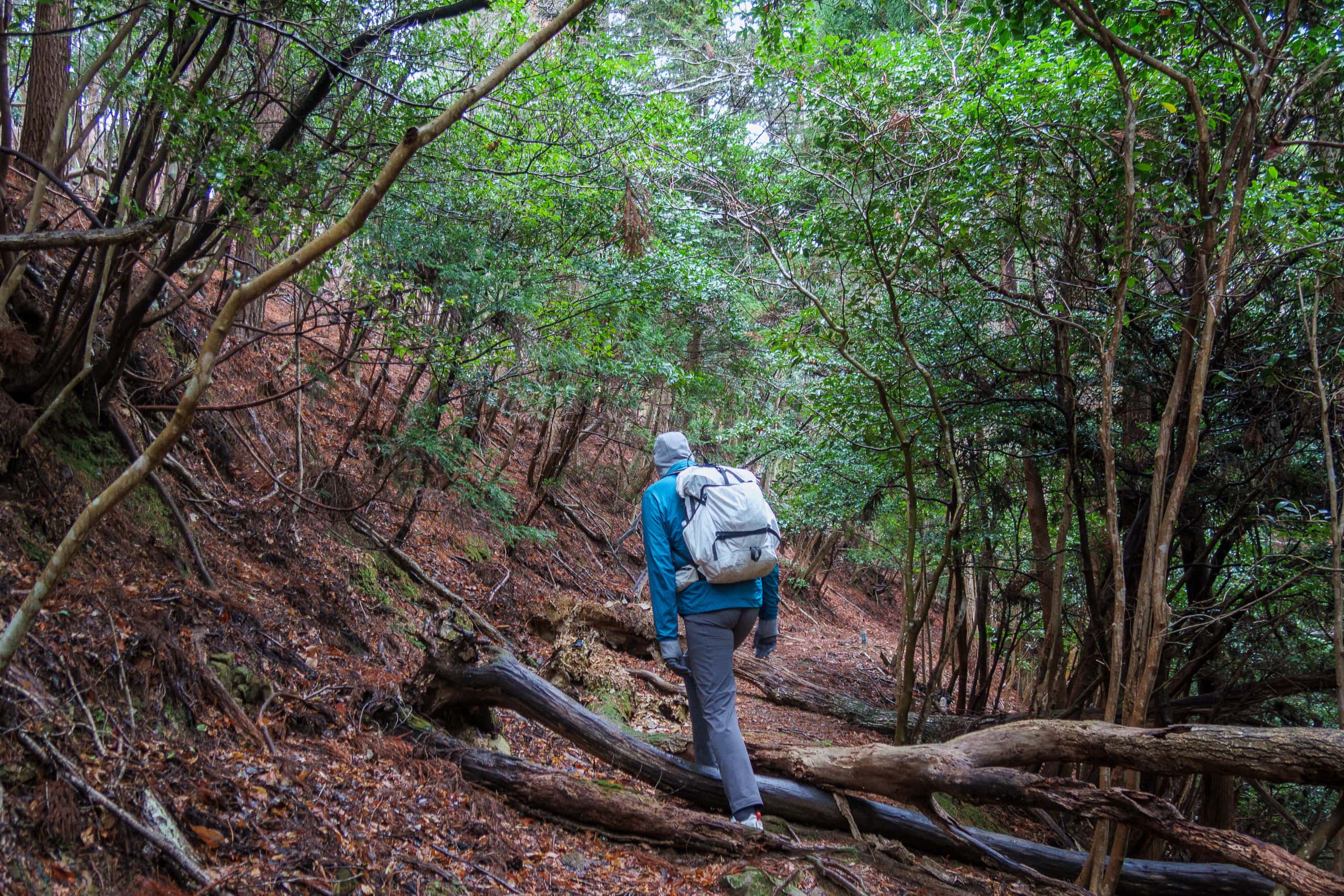


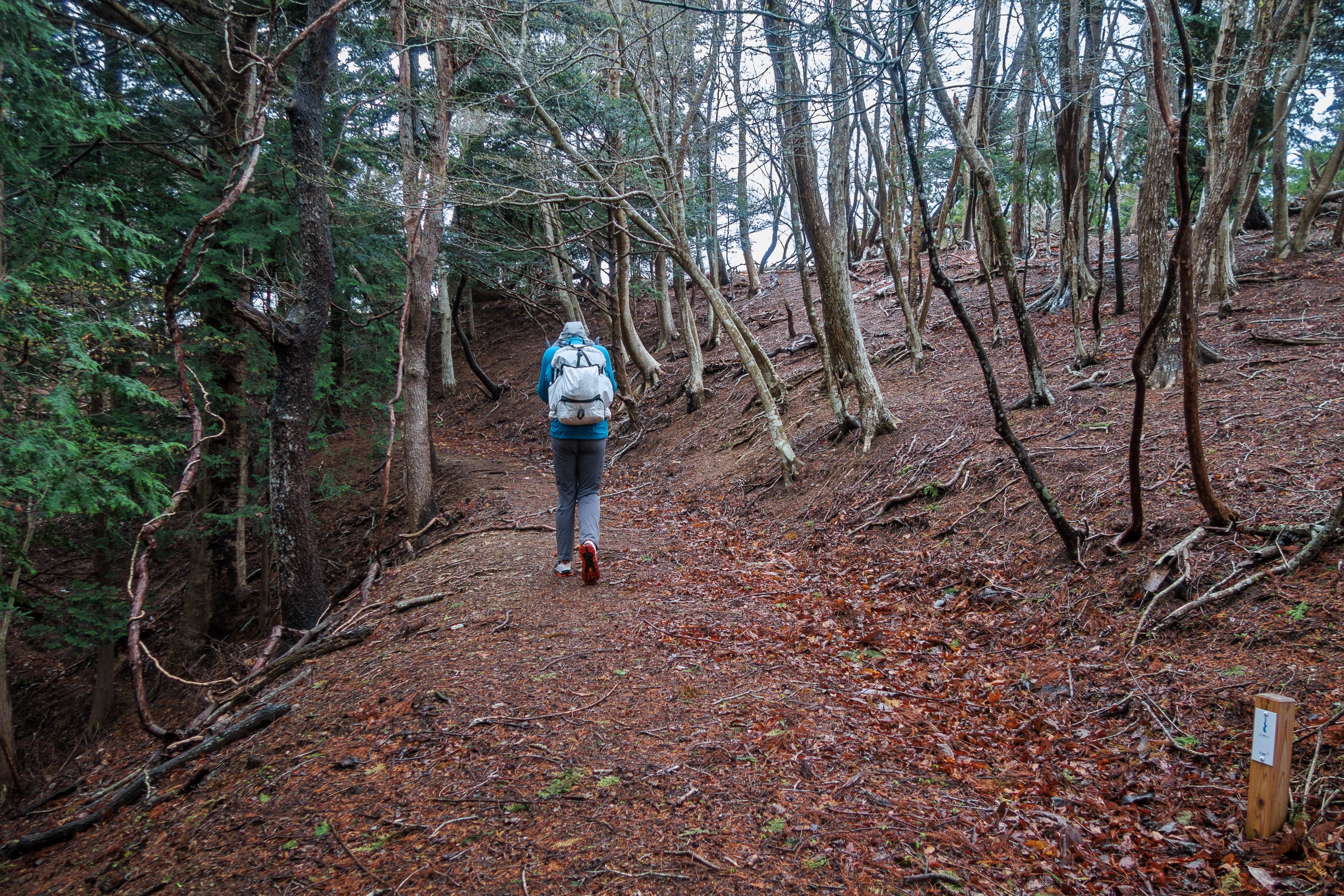




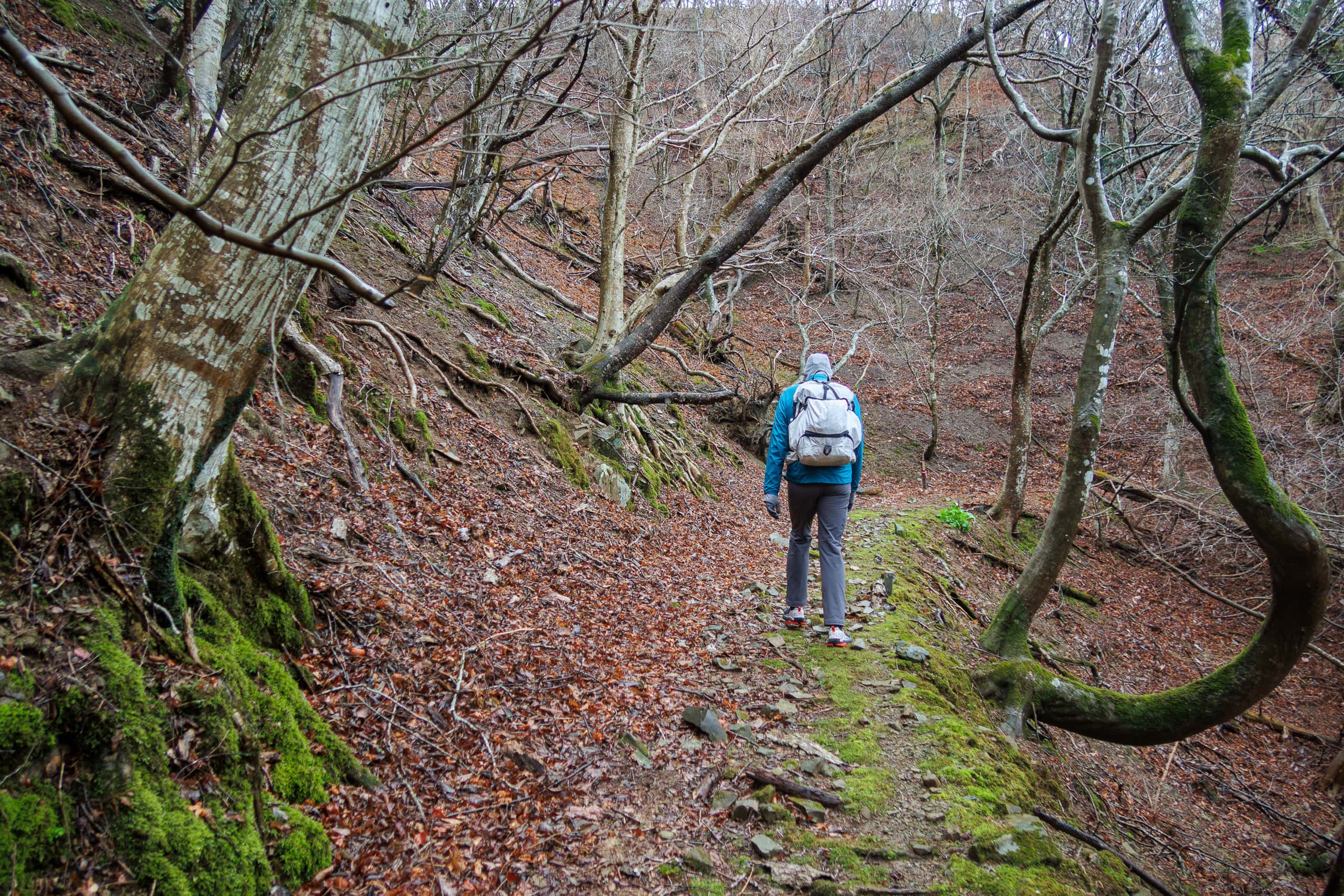

After an hour of refreshing forest bathing walk, the trail seamlessly connected to a paved forest road and returned to R-2 near a long old shrine stone stairs that looked almost vertical.


Back to the repeat of small fishery hamlets and the connecting R-2, which was, again, littered and had no decent sidewalks.
Surprisingly, my feet and back weren’t sore, and I still had good energy, thanks to cooled-down air and road surface.

We passed one more bay with two fishery ports.
At the second port, Ogihama 荻浜, we had a short break at a seemingly parking lot with white-roofed bathroom huts and a vending machine. A tiny roadside sign indicated the direction of the famous white deer sculpture.
The beautiful contrast image of the 6m tall white deer standing on a beach and the blue sky and sea appears in every Tohoku tourism promotion material. It was one of the things I wanted to see along the MCT when we were making our hiking plans. But apparently, the sculpture was at least a 10-minute walk away from R-2. We still had to walk a considerably long distance to our accommodation for tonight, yet the last stretch of mountain crossing had not come. At this point, we don’t have the luxury of using our precious 20-30 minutes just to see the white deer.
Well, we knew at least there was no blue sky and sea that set off the white deer today anyway.
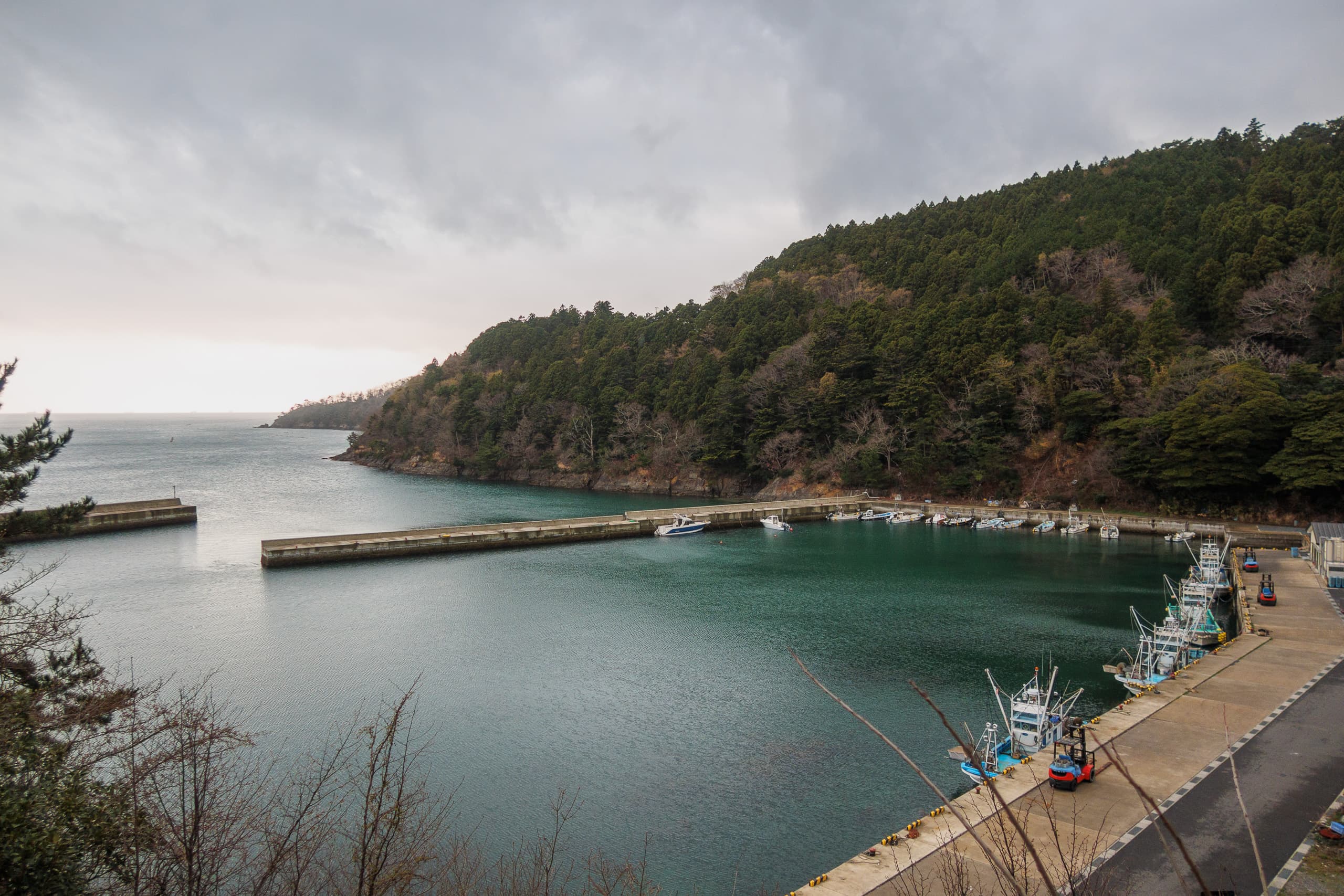
After another road-shoulder-less R-2 walk over a cape, we arrived at another fishery port bay, Samurai-hama 侍浜.
I made a phone call to our inn for tonight before going into the last natural trail, letting them know where we were then. When I booked our room, I told them that we would have a long day, so we might arrive after 5 p.m., and that we made sure to call them if that was the case.
I know very well that the biggest horror for those family-owned small-size accommodations is no show, especially when food for the guests is already prepared and waiting to be served. So, not only this case, but I always make a call by 4:30 p.m. when we are sure we won’t make it to the inn for the next 30 minutes, informing them of our current location and new estimated arrival time for their peace of mind.
Ōkoshi-Toge Pass
The last of today’s three nature trails was relatively shorter, 1.7km, through a Japanese cedar plantation mountain. The first part gradually ascended on a logging road.



Then, the MCT tapes and signs led us to a steep incline in the cedar forest. We had to really pay attention to look for the markers and carefully trace the almost non-existent track. Although markers were plenty and clear, they would be much less visible in the darker times.



The downhill was steeper, and some wet parts were slippery. Then, the route crossed a stream and went down on a narrow shoulder of the stream.
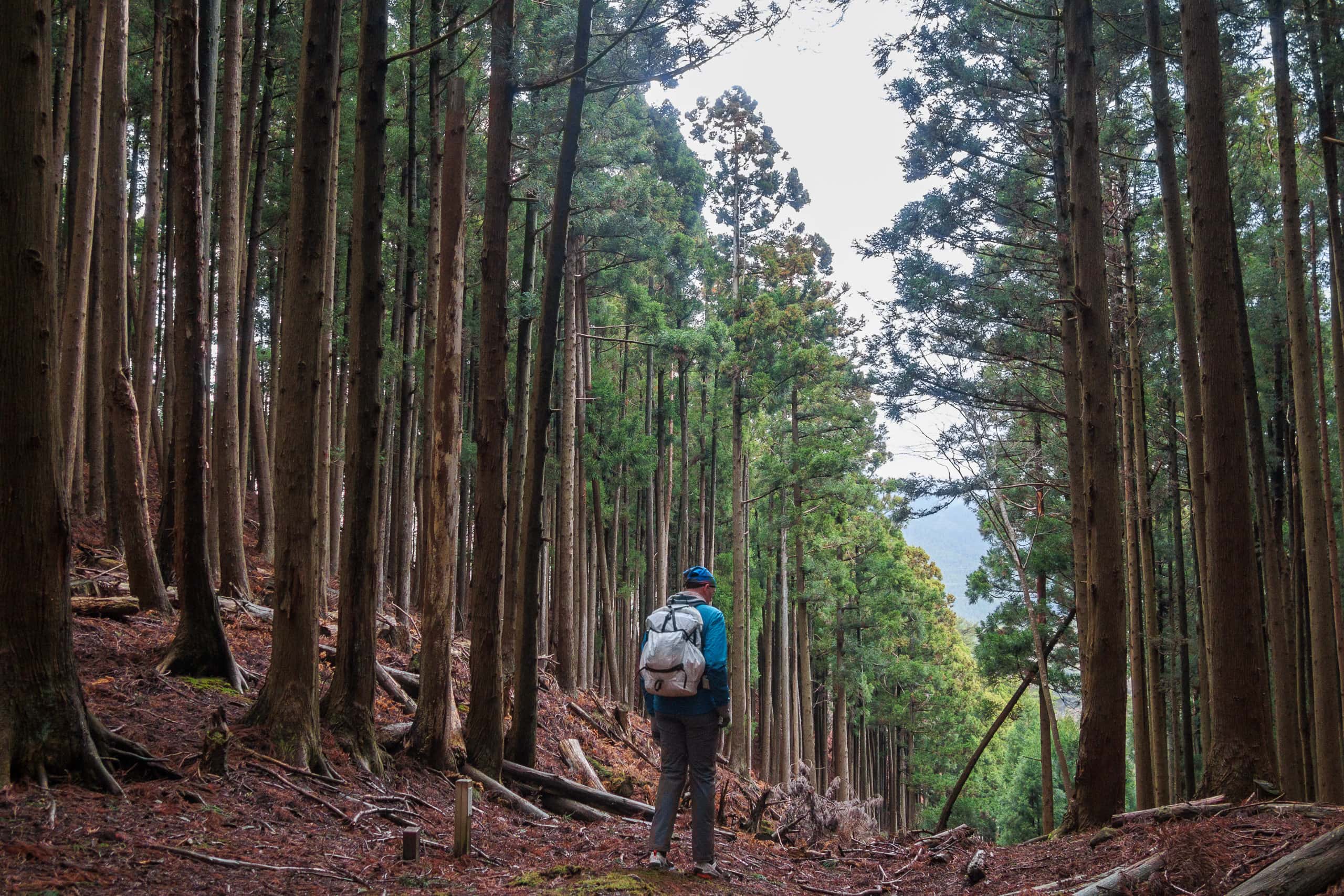




In the end, we managed to get out of the mountain trail before dark without falling.



The last 3 kilometers to our goal and hot bathtub and dinner. We passed the previous fishery port bay for today, Momonoura 桃浦. The port and surrounding open flat spaces were deadly quiet. Though the pale sunset under thick gray clouds tried to provide yellowish light, it was rapidly getting darker.



We found some pillar monuments in one of the open spaces, and a big bright blue ball-shaped thing was randomly laid on top of the rock walls behind it. This must have been another work from the Reborn-Art Festivals which is held every 2 years.

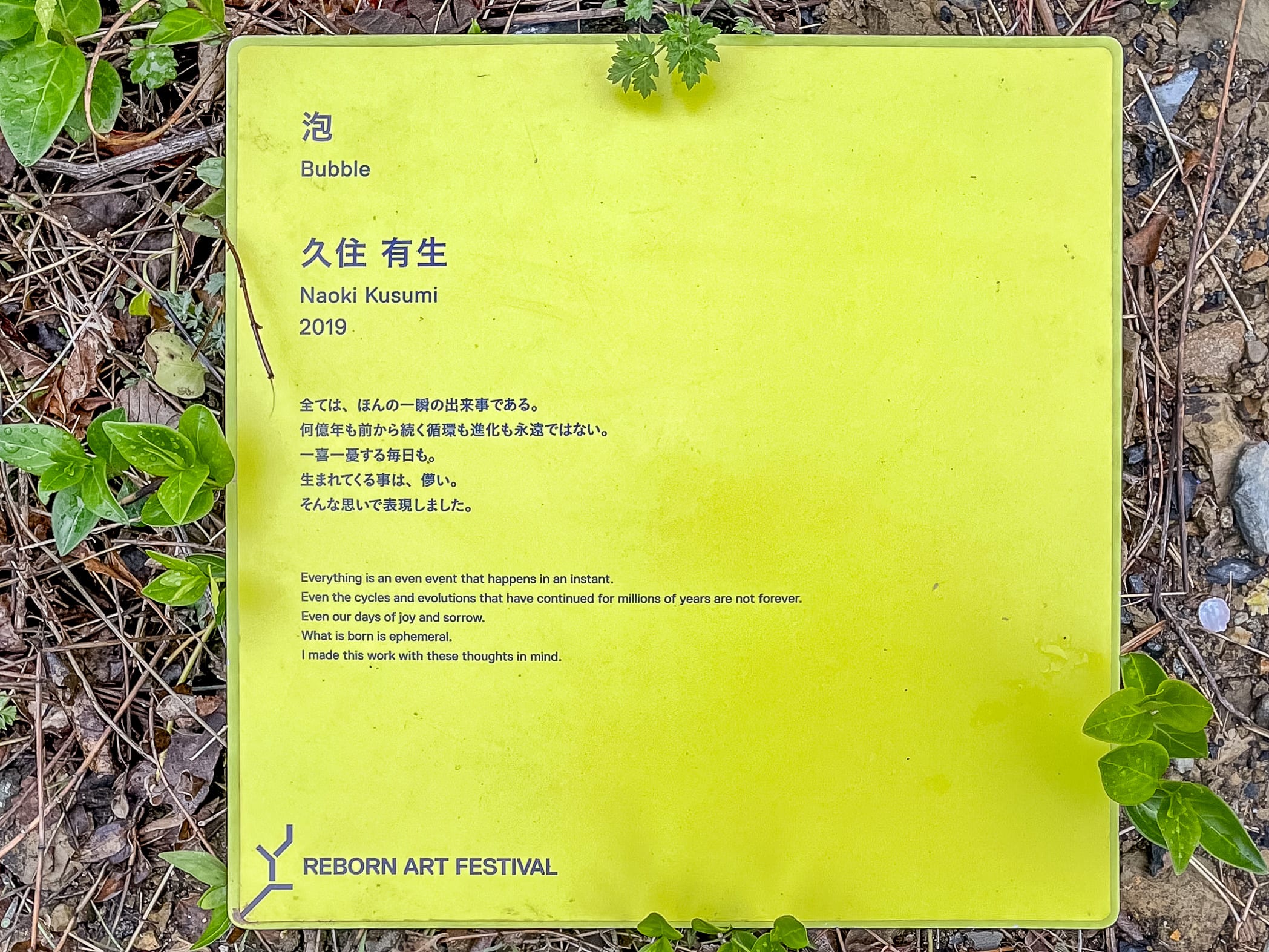

A few hundred meters before our accommodation, Zuiko 瑞幸, we passed the entrance to a short natural trail through trees. We will come back to this point tomorrow morning.


Zuiko – The best stay on the MCT
To say the least, Zuiko was one of the best accommodations we stayed in during our 50 days on the MCT.
On Google Maps, Zuiko was primarily categorized as a restaurant, but I checked out their website anyway and found they were an accommodation, too. The photos of the rooms looked nice and new.

There are no shops around, so we needed to book our room with meals. Like any other family-owned homestay-style lodgings along the MCT, Zuiko’s website showed photos of professionally cooked seafood specialties and various meal plans. All ingredients were different seafood fresh from the sea right in front of them and my childhood favorite, whale meat.
As much as I was looking forward to the seafood feast, we also had to ask them something I was terribly afraid to say to the faces at fishermen’s villages. Over the booking phone call, I tried to be straightforward and told the owner that my husband didn’t eat any seafood.
“That’s OK, no problem! I will cook meat dishes for him,” he replied with no second of hesitation.
On our arrival, the owner couple welcomed us with big smiles. Both were so friendly and nice.
Our room was very spacious, with a separate living room and sleeping room. Although it was a traditional Japanese tatami floor room, the sleeping room had two comfy beds, much to Erik’s great joy. Two sides of the living room were big windows, each providing us with excellent views of the sea. A bonus point is that the Wi-Fi was fast and stable!




After long soaking in a modern bathroom and putting our clothes in a washing machine, it was dinner time.
Erik looked like he could start dancing at the dinner table, his eyes shining, watching all the homemade meat dishes. Mine was a seafood party, just like I had hoped for.
Zuiko’s owner, the professional cook, prepared two totally different menus for each of us and used various types of meat for Erik’s. Everything tasted so good, and we also enjoyed chatting with the friendly owners.







The following day, breakfast for Erik was Western-style, with meats and, surprise! a small pizza. Erik was a perfectly happy man throughout our stay at Zuiko.
Zuiko totally surprised us with their excellent service, which was well above our expectations for a typical small-sized homestay-style accommodation in a very remote area. The room fee with two meals per person, 8800 yen including tax, was a total bargain. Truly highly recommended place to stay.
No matter how many years have passed since we completed our MCT thru-hike in spring 2021, Zuiko always comes to mind first when we recall the most memorable great accommodations.

Day 11 – MCT
| Start | Gobansho Park |
| Distance | 31.7km |
| Elevation Gain/Loss | 695m/780m |
| Finish | ZUIKO |
| Time | 9h 28m |
| Highest/Lowest Altitude | 549m/25m |
The Michinoku Coastal Trail Thru-hike: Late March – Mid-May 2021
- The first and most reliable information source about MCT is the official website
- For updates on detours, route changes, and trail closures on the MCT route
- Get the MCT Official Hiking Map Books
- Download the route GPS data provided by MCT Trail Club
- MCT hiking challengers/alumni registration











Comments